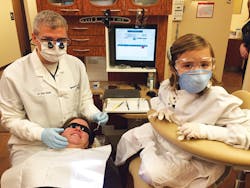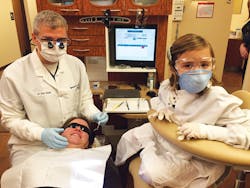Finding the perfect practice opportunity as a new dentist
I recently found myself in the unique position of searching for a new job. I was the owner of a small general dental practice and decided with my family that this was not the area where we wanted to spend the next 30 to 40 years. Of course, choosing to uproot family and career is a major decision that must be well planned. Most important in that process is finding a new dental office in which to be employed.
Phase 1:
What practice model should I choose?
First and foremost in deciding which position to accept was to define the practice model I prefer to work with. With experience as a solo practitioner, an associate, and an employee in a group practice, I examined the pros and cons of each model.
I enjoyed the freedom of working as a solo practitioner. It allowed time off when I wanted it, flexibility in my schedule, and the opportunity to add new equipment, techniques, or materials whenever I wanted. It allowed me to hire my own staff and develop my practice any way I desired. On the downside, I was responsible for many more aspects of the business than the day-to-day dentistry. There were processes to develop for ordering supplies, keeping track of OSHA and HIPAA, evaluating and reviewing employees, developing an on-call procedure, and keeping track of the practice accounting, to name a few. When the handpiece was cradled, the work of the dental practice was not complete. It took some long hours, extra learning, and failures to create a smooth set of operating procedures.
Working as an employee in a group practice allowed me the benefits of doing dentistry without the responsibilities of running a business. I was provided with insurance, paid vacation time, CE reimbursement, and no on-call responsibilities. The practice took care of the policies and procedures that dealt with the specifics of practicing dentistry. Human resources were also dealt with at an organizational level. I had several professional colleagues who were available to review cases, give advice, and socialize with on a daily basis. Basically, I could come to work, treat patients, enjoy conversations with colleagues during downtime, and go home to my family with no added responsibility. On the downside, I had to work a set schedule and request time off when I wanted to be away for vacation or a CE course. I did not have control over the materials, supplies, and equipment that were used in the facility. In general, my salary was lower than those of my counterparts in private practice. I also did not have control over the staff who performed hygiene or assisting.
I worked a short time as an associate. It was a nice blend of the two worlds. I had the opportunity to practice in an office with a respected general dentist. I was given freedom to hire my own assistant, use the materials and supplies, and take CE when I wanted. I was involved in the decision-making in the practice, though the final vote went to the practice owner. There was ample opportunity for mentoring, as the dentist I worked for set up time each week for us to meet and discuss successes, failures, and any other topics I brought to the meeting. I struggled with a few things as an associate. Patients were not always willing to see the new guy, so building my patient base was difficult. I had to buy my own insurance and benefits, and being brand-new to dentistry, this was an expensive endeavor because it came out of my income. On some days I felt like I was in the shadow of my boss, and creating my own identity was difficult, as was encouraging patients to come to my chair and not see the owner/doc.
Personally, I was not happy in solo practice. While I very much enjoyed the freedom, I found that I was not strong in the business aspects of dentistry. I became overly stressed and took much of that home to my family. I enjoyed being my own boss, doing dentistry in the manner I desired, integrating technology and new equipment, techniques, and procedures into my practice, and even selecting my own staff. However, the stress of watching the practice finances, hiring and firing staff, and managing the various policies of the practice was taxing. In the end, I focused my search on group practices-private practices, health centers, or small corporate practices. I did not concern myself with the size of the group practice at that point, only that I did not want to be in solo practice.
Phase 2:
Where do I live?
The second part of the search process was deciding where to live. This is probably the most subjective part of job hunting. Everyone has a different set of requirements and no one is wrong. Dentistry is portable and every person should seek out dental care, but some geographic areas are more saturated than others. So it pays to balance the idea of practicing in an area that needs another dentist with how it fits with your perceived requirements for living in a certain area. My wife and I decided that we like small cities that have convenient access to shopping and dining as well as quality schools and plenty of activities for our hobbies and our family as a whole. In addition, we wanted to live within reasonable proximity to a large city for access to entertainment, sporting events, and an airport. When deciding on an area to live, I recommend visiting the area to make certain you're comfortable relocating.
Phase 3:
The hunt begins
The third part is actually looking for available jobs. I used the ADA and took advantage of networking I had done at conferences to assist in my job search. First, I emailed the state dental association in the state I was targeting and asked for contacts of dentists and practices that were looking for dentists. Second, I contacted the ADA district trustee and asked if he knew whether specific offices were looking for dentists. Third, I went to the state dental association website and looked at their classified ads. Once I compiled a list of offices and practitioners looking for a dentist, I crafted a cover letter, updated my CV, and sent copies to each office. I did not email initially but sent hard copies.
Phase 4:
The interview
Fourth is the interviews and follow-ups. I was fortunate to have several interviews based on the packets I sent out. Some I was excited about, and others I did not accept. I made sure with each interview that my family was able to travel to the area with me so I was not making a unilateral decision when accepting or declining a position. Interviewing is a skill beyond the scope of this article, but it is something that should be taken very seriously. Well-thought-out answers, expectations, and questions can make or break an interview. Once an offer is presented, it is important to take adequate time to consider the specifics. Does the practice fit the way you want to perform dentistry? Is the compensation sufficient to meet your needs? Is the job offer in a location you're prepared to relocate to? If you're buying a practice, is this the place where you see yourself for the rest of your career, or is it just a starting point? If you're not buying a practice, is this a position that you plan to stay in for the short time or the long term?
After spending several months searching, interviewing, and traveling, I ultimately accepted a position in a group practice as an employee because it fit my requirements. It's in an area where my family felt comfortable, and the position allows me to practice in a way that matches my personal practice philosophy. The office had two dentists before I came on, and it's located in a growing bedroom community. The practice is a small office that's part of a large organization that has offices in only one state. This structure provides support for human resources, purchasing, technology, and accounting. It allows me to practice dentistry and interact with patients while worrying less about the business elements associated with owning an office. It also provides me the freedom to add to my skill set and implement new techniques and procedures as I desire.
It took approximately eight months to find a position that met my needs. While the job search was going on, I also had to work to sell my home and practice. This was a stressful process that involved using the help of my banker, an attorney, and a practice broker. I was fortunate enough to close on the sale of my practice and home in the same week, and I then relocated to my new home. I could not have sold a practice, a house, and found a new job on my own. I recommend using the ADA, state, and local associations when selling a practice, relocating, and pursuing a dental position. The knowledge and reach of the members in organized dentistry can help you locate dental positions and practices in your desired areas. Networking with members of the ADA also helps forge professional relationships that can be helpful as your dental career moves forward.
Eric Childs, DDS, is the ADA 9th district representative to the New Dentist Committee. Dr. Childs was the recipient of the 2013 Matt Uday New Dentist Leadership award from the Michigan Dental Association. He practices general dentistry at Dental Associates in Greenville, Wisconsin, and can be contacted at [email protected].




